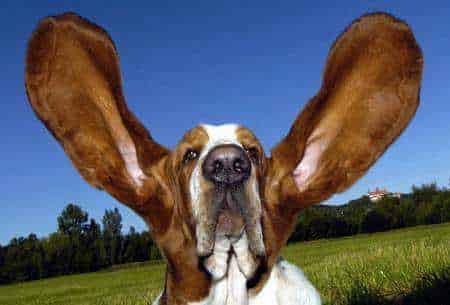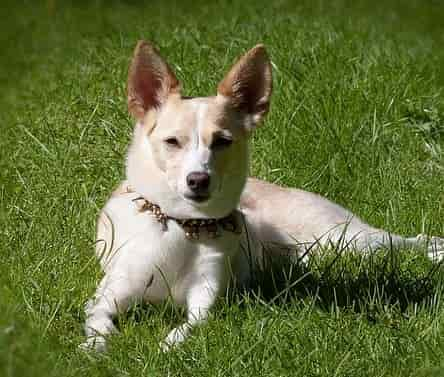Tips For Cleaning Dogs Ears Safely
Be Gentle about cleaning dogs ears - that's an absolute must! And not just with the technique, but by choosing proven products to do the job that are effective yet gentle at the same time.
 "I'm All Ears, Literally" Courtesy C.Trent
"I'm All Ears, Literally" Courtesy C.TrentHow Often To Clean Dogs Ears
The best way to know when to clean your dog's ears is to inspect them on a regular basis. Clean ears have a healthy pinkish look about them, don't smell bad and have no signs of infection. If they don't look this way, it's time for cleaning.
A dog's ears are highly vulnerable to injury or invasion by potentially damaging debris which is why they should be inspected often. Daily is ideal, but at least once a week.
One sign that your dog's ears may need cleaning is an unpleasant odor coming from them that you can't miss when he closes in for a snuggle. While this could be the result of an infection, looking inside will tell the tale.
Begin Grooming Early For Less Trauma
While the actual dog ear cleaning is not a difficult job, it needs to be done carefully to safeguard these delicate organs.
Many dogs, I think I could even say "most" dogs, are very nervous about this important part of dog grooming. Well, who can blame them, but like it or not, ear cleaning has to be done at some point.
Gaining your dog's trust is the best way to handle cleaning your dog's ears - as it also is with his other needs such as bathing, paw care, or tooth brushing.
If you start grooming early and go at it slowly, most dogs will quickly come to enjoy the process, or at the very least tolerate it :)
Conditions That Affect A Dog's Ears
Many dog breeds have long ears that cover the ear opening so well that they don't get much air circulation. This creates an environment that is perfect for bacteria, fungi, germs and parasites to flourish.
Ear mites in particular are drawn to the warm and moist atmosphere, but fleas also find this area a perfect place to thrive.
Short eared dogs are also a target for these conditions - particularly those with upright pricked or cropped ears that make it very easy for any kind of debris including insects, grass seeds, and other plant materials to enter.
 Papillon Dog Breed
Papillon Dog BreedVarious types of flies including common household flies, in search of a quick meal, can also impart painful bites to a dog's ears.
If you are doing frequent ear inspections, you will be able to spot the bite wounds and take appropriate action to prevent further fly attacks. Repeated insect bites, left untreated, can lead to dermatitis or worse conditions.
Ticks are another menace to dogs that do their frolicking in wooded areas. Try an insect repellent for dogs if your pet has a problem with flies, mosquitoes and ticks.
Pre-Cleaning Caution
Before cleaning a dog ears, the most important cautionary advice to note is that nothing should enter the ear canal which leads to the ear drum.
One way to avoid this is to pull up the outer ear flap and lay it against the head of your dog which will result in the ear canal being closed off and protected while you are cleaning.
An ounce of prevention ..is worth a pound of cure, as the saying goes and this is so true when it comes to cleaning dogs ears!
But, doing it safely is a high priority to avoid any accidental damage that could be permanent.
Best Products For Cleaning Dogs Ears
So let's get started.. First you will need to gather up some necessary supplies typically used for cleaning dogs ears such as cotton balls or gauze pads, dog ear powder, a natural dog ear wash, blunt nosed scissors or a hair remover tool such as as hemostat or forceps.
If your dog is a little reluctant or skittish when it comes to having his ears handled, try to create an environment to get him relaxed such as gently petting him, playing some soothing pet music - clinically proven to relax pets, or using calming pheromones to lower stress.
Cleaning Dogs Ears - The Nitty Gritty
- If the ear appears fairly normal but just looks dirty, the first thing to handle is the removal of excessive hair. This will improve air circulation and prevent wax build-up. Pulling out excess hair (not too much) can be done with little discomfort to your dog if only small amounts are removed at a time and you use an ear powder.
- To do it safely, pull the ear flap back as previously described and shake a little dog ear powder into it. Rub the powder around a little and then proceed to quickly pull out the hair with your hemostat or your fingers.
- Alternatively you can use the blunt nosed scissors to clip out excessive hair, very carefully.
- Next you will want to pour some of the dog ear wash into the ear while holding the flap upright. A less scary way to do this is to soak a cotton ball with the solution and gradually dribble it into the ear. Just make sure the solution circulates by massaging the outside base of the ear gently - you should be able to hear it sloshing around as you massage.
- Once you let go of the ear, your dog will shake his head to remove the remaining dog ear wash, so be prepared and stand back!
- Wipe the skin of the ear flap, outside of the ear canal, with cotton balls or gauze pads to remove the dirt and debris. To protect the delicate nature of a dogs ears, never use q-tips of any kind for cleaning.
Alternatively you can use olive oil or mineral oil for cleaning dogs ears, but never use soap and water as this can cause ear infections! Likewise for hydrogen peroxide.

When Not To Do Ear Cleaning
If your dog is showing any signs of ear problems, hold off cleaning them until after your vet takes a look as it could make things worse or make it harder to isolate the cause.
Cleaning dogs ears begins with an ear inspection. If this reveals any sign of redness, inflammation, discharge, or funky odor, chances are your dog has an ear infection - particularly if you have noticed him doing a lot of recent head shaking or scratching.
Ear mites might also be present. The best thing to do in this situation is to forgo the cleaning and take your dog to the vet as previously suggested for a proper diagnosis.
Ongoing Preventative Care
Cleaning dogs ears can be a little stressful for you and your pet, but to help keep them healthy requires ongoing preventative care. Regular inspection and cleaning is the best defense to spot and avoid problems.
Dog breeds that are hairy, have
pendulous ears, or spend considerable time playing in the water are the most prone to ear problems.
Puppies are the most prone to dog ear mites, but they can also pass them along to the mother or other adult dogs.
Home remedies
for dog ear mites often recommend using almond oil to smother the mites. A few drops placed in the
ears, after they have been cleaned, and repeated daily, is said to eliminate them after a few weeks.
There are also
several ear mite treatment products that many owners have found effective.
Before You Go...
If you like the content of this page, as well as others on my site, please give it some love by clicking on the heart in the lower right hand corner. This helps me keep providing enjoyable and useful content.
Thank you.
More Dog Care Topics
- Home ›
- Dog Grooming ›
- Cleaning Dogs Ears
Image I'm All Ears Credit: http://www.flickr.com/photos/texese/104281008/
http://creativecommons.org/licenses/by/2.0/





